I really hate washing my face over the sink – how it gets everything wet (sink, benchtop, sleeves, hair, front of my shirt), and how it takes a ton of effort to dump enough water on my face that I feel like I’ve thoroughly cleansed and rinsed away my cleanser. I generally end up washing my face in the shower, but some nights it’s too late to have a shower but my face still has stuff on it. For those times, I use this method to wash my face – I also use it on planes and while camping.
The video demonstrating this method is here on YouTube – I also bust a bunch of relevant cleansing myths in between! Keep scrolling for the text version.
Step 1: Two-Phase Eye Makeup Remover
I use Garnier 2 in 1 Makeup Remover with a reusable bamboo velour pad (Bambu Face Pads) to remove eye make-up. This step is the first step of my regular routine as well. These two-phase removers have an oily layer (usually silicone-based) on top of a layer of water, so it can remove both oil-based and water-based products and grime off your face thanks to the chemistry rule of thumb you might have come across before: “like dissolves like”.
I really like these two phase makeup removers because they gently remove waterproof make-up really quickly, with minimal tugging and irritation. Micellar water works for this too, but I find that this works faster for my skin type and makeup (although I use micellar water when I’m travelling so I have one less thing to carry).
I’ve found that some two-phase removers leave a bit of an oily residue. The oily layer in my current bottle is mostly cyclopentasiloxane, a volatile silicone that evaporates quickly after you use it, so it leaves minimal oil. The bottom water-based layer has hydrating humectants.
Unfortunately cyclopentasiloxane is gradually being phased out of cosmetic products – it’s being replaced by hydrocarbons which are a little heavier. I don’t mind the oil around my eyes, especially when I follow up with a water rinse, but I hate the feel on my face. The residue-free option – if you hate the feel, or if you want to apply make-up immediately afterwards – is micellar water.
Step 2: Cleansing Balm
This is also part of my regular routine. I massage a cleansing balm all over my face, apart from the eye area.
My long-time favourite is Then I Met You Living Cleansing Balm, which I’ve raved about many times before – I actually made Caroline Hirons a massive fan of it as well!
Other cleansing balms I’ve tried and loved:
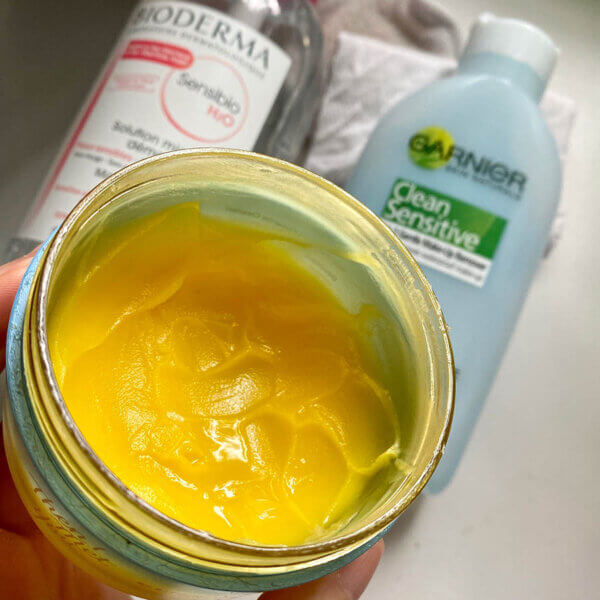
Step 3: Wipe off balm
During my regular cleansing routine, I go into the shower to wash this off. Without a shower or sink, I use a wet cotton cloth to wipe it off (I’m currently using Alpha-H Cleansing Cloths).
I use a wet wipe when I’m travelling without a water source. On the plane, I use the hot wet cloths they pass out, after a bit of shaking to cool them down. My mum tells me to never touch those though for some reason – I’m sure there’s some disgusting backstory…
Step 4: Micellar water
The final step is wiping down with micellar water. My favourite is Bioderma Sensibio H2O Micellar Water, although I’ve been using Bio Essence Bio-Water lately as well (mostly because the bottle is flatter and more portable).
I’m using terry cloth reusable cotton pads for this step, also from Bambu.
This step is just to get rid of the extra oil from the cleansing balm, and any residual dirt left over. Then I Met You’s cleansing balm leaves a bit more residue than most – for a lot of balms I can skip micellar water, even in summer.
Cleansing Myths
I covered a bunch of cleansing myths in my previous post – check that out if you can’t find the myth in this post!
Related post: Are You Washing Your Face Wrong? Busting Cleanser Myths (with video)
As always, unfortunately a lot of these answers aren’t just a simple yes or no! That’s really how a lot of myths come about – there is some grain of truth in there.
Myth: You need to use an oil cleanser to remove sunscreen or makeup, because these products are oily, and oil dissolves oil
This isn’t a blanket rule. It depends on how strong your regular cleanser is, how resistant your sunscreen is and most importantly, what you prefer to use in your routine.
Far greasier things have been removed without oil cleansers in the past – oil cleansers weren’t really popular in skincare until pretty recently, and people got on fine without it, even with the heavy greasepaint type products used in stage makeup!
Outside of skincare, we’d never consider using an oil cleanser for greasy dishes, since dishwashing liquid works so well.
The reason is surfactants, the active ingredients in dishwashing liquid and regular cleansers. They look like this:
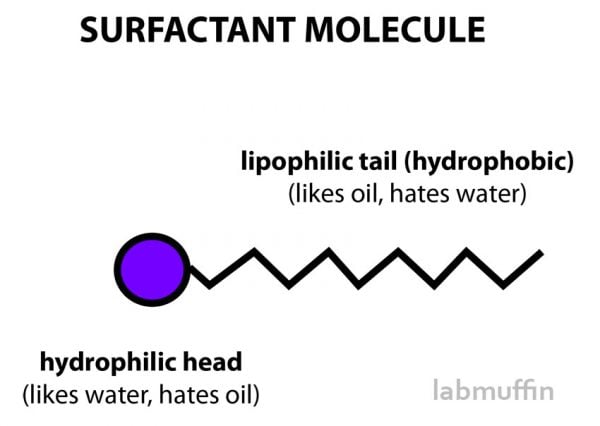
Their structures have an oily “tail” and a water loving “head” in the one package, which means that surfactants can make oil droplets disperse into water so they can get washed off. So “oil dissolves oil” still works, because the oily tail surfactant basically acts like an oil in this case.
Annalisa (@skinperspective) did a cool demonstration with a UV camera – after putting on water resistant sunscreen, she washed off one side with a regular gel cleanser and the other side with a cleansing oil followed by a gel cleanser. Both sides gave similar results.
But a lot of people (including me) still like using a cleansing oil or balm first. I like using very gentle foaming cleansers to avoid drying out my dehydration-prone skin, and I like the feeling of rubbing a balm into my face, so oil followed by water-based cleanser works best for my routine.
Myth: You need to use a water based cleanser after a cleansing oil to remove the oil
This really depends on your cleansing oil. Some of these leave more of an oily residue, and while that can usually stay on your skin without any issues, you might not like the feel of it – that’s the main reason I prefer to use a water based cleanser afterwards. However, if my skin is feeling quite dry, I skip the water-based cleanser since my skin quite likes the extra oil.
But if your skin tends to break out with certain oils, or it doesn’t react well to the ones in your oil-based cleanser, then it’s a better idea to wash it off.
Myth: Makeup wipes are terrible for your skin
Look – makeup wipes aren’t great for the environment, and if they’re the only product you ever use for cleansing, that might be a problem. A lot of makeup wipes rely mostly on solvents, which won’t work very efficiently for removing make-up and sunscreen. There are some that contain similar surfactants to micellar water though, which should work a lot better.
Apart from not removing makeup properly, ineffective wipes mean that people tend to rub really hard on their face, leading to irritation. And if you’re using these every single day, the wipe itself can act as a physical exfoliant. If your skin barrier isn’t quite up to daily physical exfoliation, that can also irritate your skin.
There’s also the waste issue. A lot of makeup wipes are made with plastic, so daily use can be a bit wasteful.
So using makeup wipes occasionally isn’t a problem – makeup wipes aren’t liquid evil, but they’re probably not the best option for your regular cleansing routine.
Myth: You always have to rinse off micellar water
This is another “it depends” situation. It mostly depends on the micellar water you’re using, because there are lots of different micellar waters on the market with different ingredients and formulas.
If you’re not sure, it’s probably safer to rinse it off… but with some micellar waters, rinsing isn’t necessary.
For example, Bioderma’s micellar water was developed specifically to work for sensitive skin in places where tap water was too irritating, as a way to avoid having to rinse with water!
We often think of surfactants as irritating ingredients that need to be washed off, but almost every skincare product you use has surfactants, including leave-on products.
One of the big reasons for this confusion is that in regular chemistry, “surfactants” refers to a big range of substances that have both water- and oil-loving sections. But in cosmetic chemistry, “surfactants” usually just refers to ingredients that are used in traditional cleansers.
I think the European Commission categorises them in a nice clear way:
- SURFACTANT – CLEANSING: Wetting body surfaces, emulsifying or solubilizing oils, and suspending soil (generally, such ingredients contribute to the foaming and lathering properties of cleansing products).
- SURFACTANT – DISPERSING: Helping distribute an insoluble solid in a liquid phase.
- SURFACTANT – EMULSIFYING: Helping suspensions or dispersions of liquids in a second liquid by reducing the surface tension of the substances to be emulsified.
- SURFACTANT – FOAM BOOSTING: Increasing foaming capacity and/or stabilize foams in general.
- SURFACTANT – HYDROTROPE: Enhancing the water solubility of another surfactant.
- SURFACTANT – SOLUBILIZING: Helping another component (solute) to dissolve in a medium in which it is not normally soluble.
So there are a lot of different functions that surfactants can have! Cleansing surfactants are the ones you find in cleansers (in case that wasn’t obvious), while emulsifying surfactants are used to make the oily and watery parts of a cream or serum hang out together without separating.
In any moisturiser there’s going to be emulsifying surfactants. For example, cetearyl alcohol is very common in moisturisers – in the EU database it’s classified as a cleansing, emulsifying and foam-boosting surfactant.
So clearly some surfactants can be left on your skin without problems, while others can’t. And of course it depends on the concentrations and the rest of the formula too.
The surfactant Bioderma use in their micellar waters is PEG-6 caprylic/capric glycerides, which is classified as an emulsifying surfactant. It isn’t used as a cleansing ingredient in regular cleansers, but is sometimes added as a superfatting agent. These are ingredients that are added to cleansers to make them more gentle. They work a bit like emollient oils to hydrate and moisturise skin.
Another micellar water I really like is Bio Essence Bio-Water – this also uses PEG-6 caprylic/capric glycerides as well as another gentle one, PEG-7 glyceryl cocoate.
Unilever have also presented research showing that one of their micellar waters is as gentle as regular water. I’m assuming it’s Simple Micellar Water, which also uses PEG-6 caprylic/capric glycerides.
There are definitely micellar waters out there with surfactants that are more irritating, so rinsing those is probably a good idea. It’s also a good idea to pay attention to your skin, so if you’re having trouble with any micellar water, try rinsing it afterwards. As well as the surfactants, there are other elements of the formula that could be irritating, such as a fragrance ingredient, a preservative or even the pH of the micellar water.
It could also be just the cotton pads you’re using – I found that with rougher pads my skin became a bit irritated, just from that extra physical exfoliation. I’ve found that reusable cotton pads are a lot softer than the disposable pads I had previously, and haven’t had an issue since switching (another reason to change!).
Myth: You need to cleanse / double cleanse in the morning
There is stuff to cleanse off your face in the morning – any products you apply at night, any sweat and sebum your skin produces, any dust falling on your face. But otherwise, your face is probably quite clean in the morning already, if you cleansed it thoroughly at night!
Some people were concerned about occlusive night-time products “blocking” their daytime products from penetrating. Your products get wiped off onto your pillowcase throughout the night, and in general, it’s really difficult for skincare products to form a solid film on your skin that other substances can’t get through.
There’s been attempts to make barrier creams for people who handle irritating substances, but due to your skin’s natural biology (cells shedding off, sweat and sebum being secreted, lots of movement) these have been pretty unsuccessful. So your moisturisers are very unlikely to block your daytime products from getting into your skin!
By default, most studies with cleansers have been done with people who have acne, and the protocol requires cleansing twice a day. As far as I know, there hasn’t been a study on once vs twice a day cleansing.
I personally found that not washing my face in the morning with a proper cleanser was beneficial. I have very dehydration-prone skin that easily becomes tight and uncomfortable with cleansers, and cleansing in the morning led to me being very oily throughout the day. But when I was wearing masks a lot, my skin broke out more, and a quick cleanse with micellar water in the morning improved my skin.
So I think this is a very individual thing. It really depends on your skin and your products, and it isn’t a hard-and-fast rule that you have to cleanse a certain number of times a day. I’m sure we all know someone who never washes their face properly, uses no skin care products, and their skin is fine!
Some of the mentioned products were provided for editorial consideration, which did not affect my opinion. This post also contains affiliate links – if you decide to click through and support Lab Muffin financially (at no extra cost to you), thank you! For more information, see Disclosure Policy.


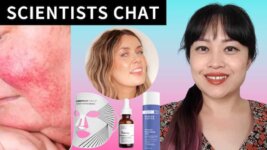
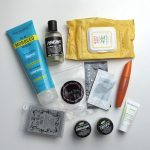

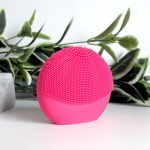
Oh man, thank you so much for this! I also hate washing my face in the sink, and the water seems to irritate my skin anyway. I’ve just been using salicylic acid pads, but they’re not great at removing makeup and I’m worried about the environmental impact, so this is the perfect post for me!
I do love me some cleansing balms! I always wash them off with water though. I’m just wondering what you do when you’re using these without water – I assume you just wipe them off with a towel or your bamboo puff? You didn’t mention it. I would love to occasionally just skip using the sink also, sometimes a girl is just too tired for that shit 😄
Great post, thank you! I wish I didn’t have to wash my face in the morning haha, I’ve tried not doing that and I break out. Lame. 😏
Oh and I was always so concerned about not rinsing micellar water off my face! That was good information to know!
“[…] cyclopentasiloxane is gradually being phased out of cosmetic products […]” Did not know this, am potentially so pleased! Does this mean it’s NOT going to be the primary ingredient in seemingly 90% of foundations, BB creams, CC creams, tinted moisturizers, and primers? Because that’s the first thing I look for in the ingredients list — one use guarantees me a face full of rapidly developing deep cystic zits. Evvvvery single time. No cyclomethicones for me. 🙁
There’re so many ingredients I avoid bc they seem to contribute to breakouts, so my go-to remover of stubborn makeup is plain old squalane oil. Easy! Multipurpose! Relatively cheap!
Yep – they’ll be replaced with alternatives, fingers crossed your skin likes the replacements!
I don’t always cleanse twice (or even double cleanse) – like you said, it depends on the skin and for me a lot on the weather and what I did. If it is hot in summer and nights are sweaty, I tend to cleanse in the mornings, in the cooler months though I just splash some water around the eyes to wke them up.
Same goes for Double Cleansing, it totally depends on what I did throughout the day, how much makeup I have been wearing and whether or not I did reapply sunscreen repeately.
Thank you so much for this Michelle. I travel a lot (or at least I did) and I’m not always able to take everything with me or have access to a sink, so it’s great to know that I’ve still got options. Great explanations as always 🙂
Thanks for answering my question about cleansing in the morning!
A formulator I’ve followed for quite awhile has said more or less than oil cleansing blocks your skin from absorbing any follow up active ingredients. Can you help me unpack this
” Oils are BIG molecules. Spreading oil on your face will cover the skin and prevent anything from reaching its surface.”
That doesn’t make sense, there are gaps in between the molecules… https://labmuffin.com/skincare-layering-not-actually-about-molecular-size/
I’m so sorry to tell you that I *might* know the “disgusting” reason your mom told you not to use those hot towels on your face.
I lived in China for many years and on a trip from China to Thailand I was horrified to discover that the man a couple of seats over took the towel just as causal as you please and shoved down the front of his pants for a solid washing before surrendering it to the dirty towel pick up.
You just never know where those have been…
Love the site. Keep them coming!
THANKS FOR PROVIDING MY NIGHTMARE FUEL FOR THE NEXT FIFTEEN YEARS